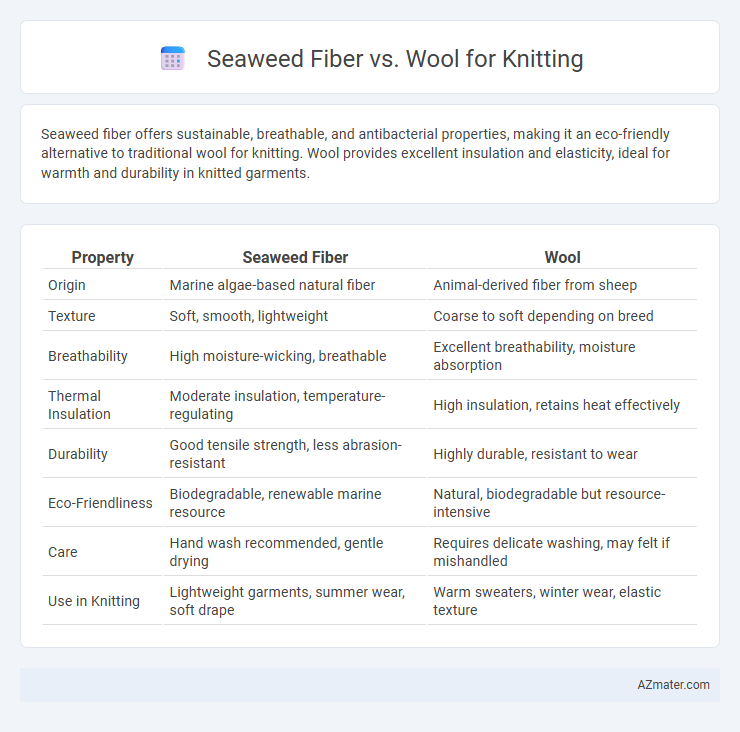Seaweed fiber offers sustainable, breathable, and antibacterial properties, making it an eco-friendly alternative to traditional wool for knitting. Wool provides excellent insulation and elasticity, ideal for warmth and durability in knitted garments.
Table of Comparison
| Property | Seaweed Fiber | Wool |
|---|---|---|
| Origin | Marine algae-based natural fiber | Animal-derived fiber from sheep |
| Texture | Soft, smooth, lightweight | Coarse to soft depending on breed |
| Breathability | High moisture-wicking, breathable | Excellent breathability, moisture absorption |
| Thermal Insulation | Moderate insulation, temperature-regulating | High insulation, retains heat effectively |
| Durability | Good tensile strength, less abrasion-resistant | Highly durable, resistant to wear |
| Eco-Friendliness | Biodegradable, renewable marine resource | Natural, biodegradable but resource-intensive |
| Care | Hand wash recommended, gentle drying | Requires delicate washing, may felt if mishandled |
| Use in Knitting | Lightweight garments, summer wear, soft drape | Warm sweaters, winter wear, elastic texture |
Introduction to Natural Fibers in Knitting
Seaweed fiber, derived from sustainably harvested marine algae, offers a soft, breathable, and eco-friendly alternative to traditional wool in knitting projects. Wool, sourced from sheep fleece, provides excellent insulation, durability, and elasticity ideal for warmth and texture in garments. Natural fibers like seaweed and wool each bring unique properties that influence stitch definition, comfort, and sustainability in knitted fabrics.
What is Seaweed Fiber Yarn?
Seaweed fiber yarn is an innovative textile material derived from seaweed algae, renowned for its sustainability and natural antibacterial properties. Rich in minerals and vitamins, this eco-friendly yarn offers a soft, silky texture that is moisture-wicking and breathable, making it ideal for sensitive skin and warmer climates. Compared to traditional wool, seaweed fiber yarn provides a lightweight, hypoallergenic alternative with strong environmental benefits due to its renewable marine source.
Wool: A Classic Knitting Staple
Wool remains a classic knitting staple prized for its exceptional warmth, elasticity, and moisture-wicking properties, making it ideal for cozy garments and accessories. Unlike seaweed fiber, wool offers superior breathability and natural insulation, which helps regulate body temperature in varying climates. Its durability and ability to hold shape over time ensure long-lasting, comfortable knitwear favored by both traditional and modern artisans.
Comparing Texture and Softness
Seaweed fiber offers a smooth, silky texture with natural moisture-wicking properties, making it exceptionally soft and breathable for knitting projects. Wool, known for its elasticity and warmth, provides a cozier and slightly denser feel but can vary in softness depending on the sheep breed. Comparing the two, seaweed fiber tends to be gentler on sensitive skin, while wool excels in insulation and durability for cold-weather garments.
Warmth and Insulation Properties
Seaweed fiber offers natural thermal regulation by retaining warmth while remaining breathable, making it effective for insulation in knitting projects. Wool provides superior warmth thanks to its crimped structure, trapping air effectively to create an insulating layer against cold temperatures. Comparing insulation properties, wool outperforms seaweed fiber in extreme cold conditions, though seaweed fiber excels in moisture-wicking and temperature balance.
Breathability and Moisture Management
Seaweed fiber offers superior breathability compared to wool, thanks to its natural porous structure that enhances air circulation and prevents overheating. Its moisture-wicking properties efficiently draw sweat away from the skin, keeping the wearer dry and comfortable during prolonged activity. Wool also provides effective moisture management by absorbing up to 30% of its weight in moisture without feeling wet, but seaweed fiber excels in promoting a cooler, drier experience in warm or humid conditions.
Sustainability and Eco-Friendliness
Seaweed fiber offers a highly sustainable alternative to wool, as it is biodegradable, renewable, and requires minimal water and land resources during cultivation, significantly reducing environmental impact. Wool, while natural and biodegradable, often involves intensive land use and methane emissions from sheep farming, impacting its eco-friendliness compared to seaweed fiber. Choosing seaweed fiber for knitting supports sustainable fashion by promoting marine resource utilization without contributing to deforestation or greenhouse gas emissions.
Care and Durability Differences
Seaweed fiber offers natural antibacterial properties and moisture-wicking abilities, requiring gentle hand washing and air drying to maintain its softness and elasticity. Wool, known for its resilience and warmth, demands careful wool-specific detergent use and controlled drying to prevent shrinking and felting. While seaweed fiber may degrade faster with frequent washing, wool provides superior long-term durability and shape retention under proper care conditions.
Best Knitting Projects for Each Fiber
Seaweed fiber excels in lightweight, breathable knitting projects such as summer tops, scarves, and baby garments due to its natural moisture-wicking and antibacterial properties. Wool is ideal for warm, insulating items like sweaters, hats, and gloves, providing exceptional durability and elasticity for complex stitch patterns. Both fibers offer unique benefits, with seaweed fiber enhancing softness and sheen, while wool supports thermal regulation and resilience in cold-weather accessories.
Choosing the Right Fiber for Your Needs
Seaweed fiber offers natural antibacterial properties and excellent moisture-wicking capabilities, making it ideal for lightweight, breathable garments perfect for sensitive skin and warm climates. Wool provides superior insulation, durability, and elasticity, best suited for warmth and structured knitting projects in cooler environments. Selecting between seaweed fiber and wool depends on balancing breathability, insulation, and fabric resilience based on your specific knitting project requirements and climate conditions.

Infographic: Seaweed fiber vs Wool for Knitting
 azmater.com
azmater.com